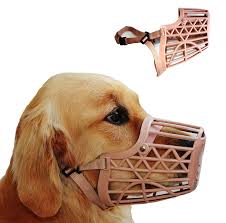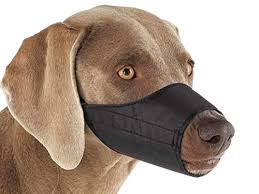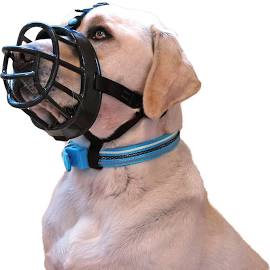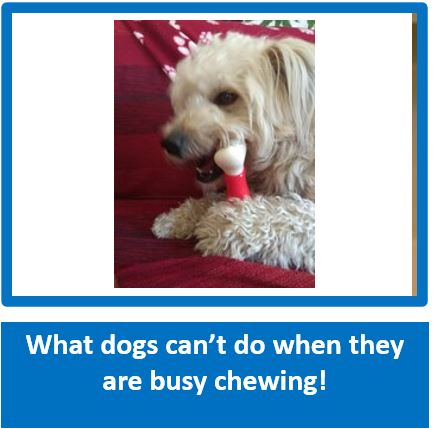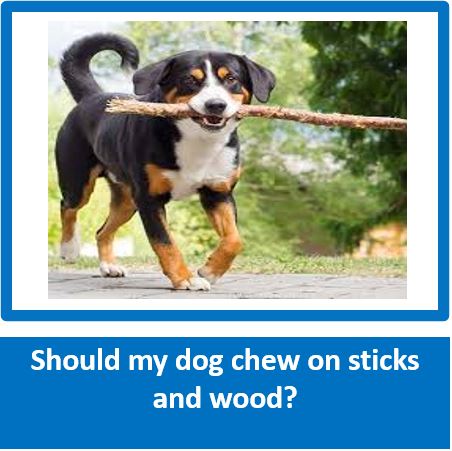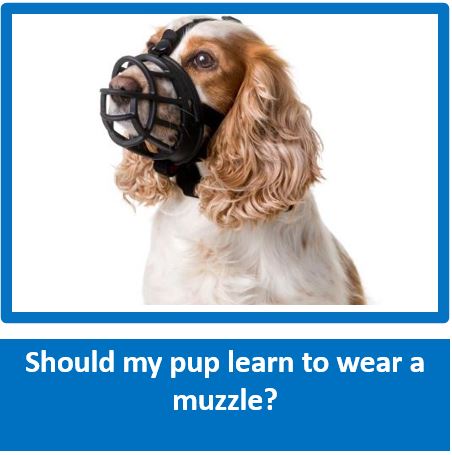
We have just about everything your dog may need, including the Rosewood Soft Basket Muzzle, for all sizes of dogs. The open design allows for panting, drinking and feeding. The flexible silicone basket and soft padded neoprene-lined straps keep the dog comfortable during use. Dogs should never be left alone in a muzzle, and should always be desensitized to them in the correct manner. While on our website, do have a look at all other fabulous products we have for not just your dog, but also your kitty and 'little critters'. www.mcmac.co.za
FOTD - When choosing a muzzle for your dog, ensure that the dog can open it's mouth, drink and be offered treats while wearing it.
Dog Muzzles can be a very helpful aid to a dog training program, but they can also be dangerous if used improperly. Our certified dog trainer and owner, Jess Rollins, wrote up these dog muzzle guidelines to help you decide if a muzzle is the right tool for you and your dog and to help make you aware of some of the potential problems. Please note, that using a muzzle does not guarantee your safety when working with a dangerous dog. Pet Expertise does not assume any responsibility for injuries involved in the use of a dog muzzle. Be careful and be safe!
Do: Teach your dog to be comfortable wearing a muzzle using rewards and a lot of patience. This will help your dog to relax while wearing the muzzle and not struggle so much to get it off. (FOTD - Article at bottom to desensitize your dog properly to a muzzle - although this article is based on pups - the process is identical for an adult dog. )
Do: Make sure that your dog's muzzle fits properly and is secure. If your dog will be wearing the muzzle for more than a few minutes, make sure it allows for your dog to open his or her mouth to pant.
Do: Use the muzzle as a safety aid for your dog's fear or aggression training program. Working with a well qualified, positive traineris the best way to go!
Don't: Use a muzzle to "fix" a fear or aggression problem. Using the muzzle this way could make the aggression worse. Teaching your dog to be comfortable around what he is upset about by using positive training while using a muzzle as a safety measure is the most effective way to help your dog.
Don't: Leave a muzzle on your dog while unattended. Your dog could scratch at it to try to get it off and injure himself.
Don't: Trust a muzzle completely, as dogs can be amazing Houdinis at the most inopportune moments! A back up plan such as a leash is always a good idea.
Don't: Use a muzzle as a replacement for a crate and other prevention methods to stop destructive chewing when you are not there to supervise. This could result in your dog injuring himself trying to get the muzzle off or in other behavioral problems due to frustration.
Don't: Use a muzzle as a way to get dogs to stop fighting with each other. Dogs can still fight while muzzled and injure themselves and could make the fighting issue worse. It's best to use a muzzle as a safety measure together with positive training methods to help your dog's learn to like each other.
Don't: Use a tube or grooming style muzzle that restricts your dog from panting for more than a few minutes at a time. Dogs can overheat very easily. A better option, is a basket-type muzzle.
Don't: Muzzle your dog for off-leash play unless you are preventing your dog from eating objects and are using it as a safety back up for that. If your dog has a fear or aggression problem, a muzzle can be a helpful safety measure, but you should also keep him leashed so that you can supervise interactions.
Don't: Use a muzzle on an unsupervised dog to stop a barking problem. Most likely if your dog is barking while you are away he is either anxious or bored and the problem would be best solved using positive training methods to help your dog be comfortable alone or by providing more exercise or puzzle toys and chew toys. Muzzling a barking dog while unattended could cause the issue to become worse or your dog to injure him or herself by trying to remove the muzzle.
Do: Teach your dog to be comfortable wearing a muzzle using rewards and a lot of patience. This will help your dog to relax while wearing the muzzle and not struggle so much to get it off. (FOTD - Article at bottom to desensitize your dog properly to a muzzle - although this article is based on pups - the process is identical for an adult dog. )
Do: Make sure that your dog's muzzle fits properly and is secure. If your dog will be wearing the muzzle for more than a few minutes, make sure it allows for your dog to open his or her mouth to pant.
Do: Use the muzzle as a safety aid for your dog's fear or aggression training program. Working with a well qualified, positive traineris the best way to go!
Don't: Use a muzzle to "fix" a fear or aggression problem. Using the muzzle this way could make the aggression worse. Teaching your dog to be comfortable around what he is upset about by using positive training while using a muzzle as a safety measure is the most effective way to help your dog.
Don't: Leave a muzzle on your dog while unattended. Your dog could scratch at it to try to get it off and injure himself.
Don't: Trust a muzzle completely, as dogs can be amazing Houdinis at the most inopportune moments! A back up plan such as a leash is always a good idea.
Don't: Use a muzzle as a replacement for a crate and other prevention methods to stop destructive chewing when you are not there to supervise. This could result in your dog injuring himself trying to get the muzzle off or in other behavioral problems due to frustration.
Don't: Use a muzzle as a way to get dogs to stop fighting with each other. Dogs can still fight while muzzled and injure themselves and could make the fighting issue worse. It's best to use a muzzle as a safety measure together with positive training methods to help your dog's learn to like each other.
Don't: Use a tube or grooming style muzzle that restricts your dog from panting for more than a few minutes at a time. Dogs can overheat very easily. A better option, is a basket-type muzzle.
Don't: Muzzle your dog for off-leash play unless you are preventing your dog from eating objects and are using it as a safety back up for that. If your dog has a fear or aggression problem, a muzzle can be a helpful safety measure, but you should also keep him leashed so that you can supervise interactions.
Don't: Use a muzzle on an unsupervised dog to stop a barking problem. Most likely if your dog is barking while you are away he is either anxious or bored and the problem would be best solved using positive training methods to help your dog be comfortable alone or by providing more exercise or puzzle toys and chew toys. Muzzling a barking dog while unattended could cause the issue to become worse or your dog to injure him or herself by trying to remove the muzzle.

